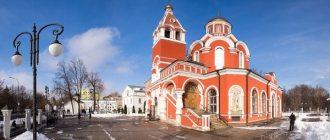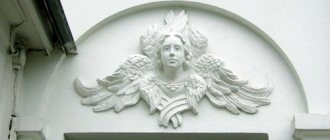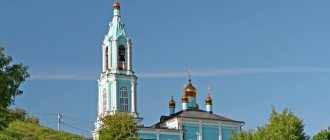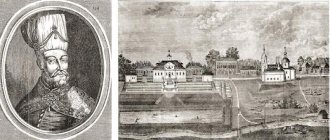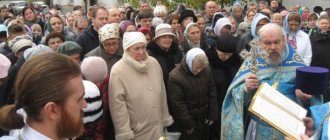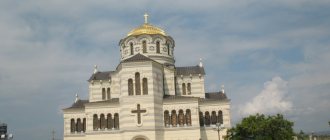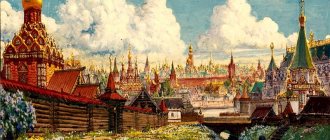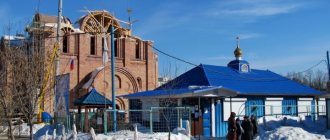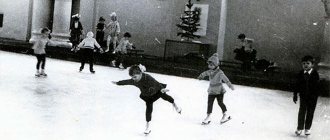Mir
Russia Moscow Church of the Intercession of the Blessed Virgin Mary in Medvedkovo (Moscow) Map is loading…
{"format":"leaflet","minzoom":false,"maxzoom":false,"limit":50,"offset":0,"link":"all","sort":[""], "order":[],"headers":"show","mainlabel":"","intro":"","outro":"","searchlabel":"\u2026 \u0441\u043b\u0435\ u0434\u0443\u044e\u0449\u0438\u0435 \u0440\u0435\u0437\u0443\u043b\u044c\u0442\u0430\u0442\u044b","default":"","import-annotation":false,"width ":"auto","height":"350px","centre":{"text":"","title":"""link":"""lat":55.8652680000000003701643436215817928314208984375,"lon": 37.63802700000000100999386631883680820465087890625,"icon":""},"title":"","label":"","icon":"","lines":[],"polygons":[],"circles":[ ],"rectangles":[],"copycoords":false,"static":false,"zoom":8,"defzoom":14,"layers":["OpenStreetMap"],"image layers":[] ,"overlays":[],"resizable":false,"fullscreen":true,"scrollwheelzoom":true,"cluster":false,"clustermaxzoom":9,"clusterzoomonclick":true,"clustermaxradius":80, "clusterspiderfy":true,"geojson":"","clicktarget":"","showtitle":true,"hidenamespace":false,"template":"","userparam":"","activeicon": "","pagelabel":false,"ajaxcoordproperty":"","ajaxquery":"","locations":[{"text":"\u003Cb\u003E\u003Ca href=\"/palomnik/%D0% A5%D1%80%D0%B0%D0%BC_%D0%9F%D0%BE%D0%BA%D1%80%D0%BE%D0%B2%D0%B0_%D0%9F%D1%80% D0%B5%D1%81%D0%B2%D1%8F%D1%82%D0%BE%D0%B9_%D0%91%D0%BE%D0%B3%D0%BE%D1%80%D0% BE%D0%B4%D0%B8%D1%86%D1%8B_%D0%B2_%D0%9C%D0%B5%D0%B4%D0%B2%D0%B5%D0%B4%D0%BA% D0%BE%D0%B2%D0%B5_(%D0%9C%D0%BE%D1%81%D0%BA%D0%B2%D0%B0)\» title=\»\u0425\u0440\u0430\ u043c \u041f\u043e\u043a\u0440\u043e\u0432\u0430 \u041f\u0440\u0435\u0441\u0432\u044f\u0442\u043e\u0439 \u0411\u043e\u0433\u 043e\u0440\u043e\u0434\u0438\ u0446\u044b \u0432 \u041c\u0435\u0434\u0432\u0435\u0434\u043a\u043e\u0432\u0435 (\u041c\u043e\u0441\u043a\u0432\u0430)\u003 E\u0425\u0440\u0430\ u043c \u041f\u043e\u043a\u0440\u043e\u0432\u0430 \u041f\u0440\u0435\u0441\u0432\u044f\u0442\u043e\u0439 \u0411\u043e\u0433\u 043e\u0440\u043e\u0434\u0438\ u0446\u044b \u0432 \u041c\u0435\u0434\u0432\u0435\u0434\u043a\u043e\u0432\u0435 (\u041c\u043e\u0441\u043a\u0432\u0430)\u003C/ a\u003E\u003C/b\ u003E\u003Chr /\u003E\u003Ca href=\»/palomnik/%D0%A1%D0%B2%D0%BE%D0%B9%D1%81%D1%82%D0%B2%D0%BE:%D0 %90%D0%BD%D0%BD%D0%BE%D1%82%D0%B0%D1%86%D0%B8%D1%8F\" title=\"\u0421\u0432\u043e\u0439\u0441 \u0442\u0432\u043e:\u0410\u043d\u043d\u043e\u0442\u0430\u0446\u0438\u044f\»\u003E\u0410\u043d\u043d\u043e\u0442\u0430\u0446 \u0438\u044f\u003C/ a\u003E: \u0420\u0430\u0441\u043f\u043e\u043b\u0430\u0433\u0430\u0435\u0442\u0441\u044f \u0432 \u041c\u0435\u0434\u0432\u043 5\u0434\u043a\u043e\u0432 \u043e, \u043d\u0430 \u043f\u0440\u0430\u0432\u043e\u043c \u0431\u0435\u0440\u0435\u0433\u0443 \u0440\u0435\u043a\u0438 \u0 42f\u0443\u0437\u044b,\u043d \u0435\u0434\u0430\u043b\u0435\u043a\u043e \u043e\u0442 \u043c\u0435\u0441\u0442\u0430 \u0432\u043f\u0430\u0434\u0435\u043d \u0438\u044f \u0432 \u043d\u0435 \u0451 \u0440\u0435\u043a\u0438 \u0427\u0435\u0440\u043c\u044f\u043d\u043a\u0438. \u041f\u0440\u0438 \u0445\u0440\u0430\u043c\u0435 \u0438\u043c\u0435\u0435\u0442\u0441\u044f \u043a\u043b\u0430\u0434\u0431 \u0438\u0449\u0435.","" title":"\u0425\u0440\u0430\u043c \u041f\u043e\u043a\u0440\u043e\u0432\u0430 \u041f\u0440\u0435\u0441\u0432\u044f\u0442\u043e\u04 39\u0411\u043e\u0433 \u043e\u0440\u043e\u0434\u0438\u0446\u044b \u0432 \u041c\u0435\u0434\u0432\u0435\u0434\u043a\u043e\u0432\u0435 (\u041c\u043e \u0441\u043a\u0432\u0430) ""link":"","lat":55.8652680000000003701643436215817928314208984375,"lon":37.63802700000000100999386631883680820465087890625,"icon":"" }],"imageLayers":[]}
55.865298; 37.638135
Russia, Moscow, Zapovednaya street, 52Ас1
Moscow
Russia
Telephone:
+7 (499) 186-86-47
Church of the Intercession of the Blessed Virgin Mary in Medvedkovo
(Pokrovskaya Church, Bogoroditskaya Church) is an Orthodox church in the north of Moscow in the South Medvedkovo district. Belongs to the Sergievsky deanery of the Moscow city diocese. It is located in Medvedkovo, on the right bank of the Yauza River, not far from the confluence of the Chermyanka River. There is a cemetery next to the temple.
History[edit]
The village of Medvedkovo in surviving sources was first mentioned in a scribe book of 1623 as the possession of the boyar Prince Dmitry Mikhailovich Pozharsky, the liberator of Russia from the Poles, “like his father’s ancient patrimony.”
The name “Medvedevo” (this is what the village was originally called) comes from its first owner, Prince Vasily Feodorovich Medved Pozharsky, who lived in the 1st half. XVI century
After the liberation of Moscow, D.M. Pozharsky makes Medvedkovo his main residence near Moscow. In 1623, according to documents, a wooden tent church was erected in the village in honor of the Intercession of the Most Holy Theotokos, for which the prince ordered a special bell to be cast in memory of the liberation of Moscow. The temple had another chapel in honor of St. Peter of Alexandria, who was the heavenly patron of the first son of D.M. Pozharsky (celebrated on December 8 according to the New Style).
In 1634-1635 The prince built a new stone church in Medvedkovo on the site of an old wooden church, also in honor of the Feast of the Intercession of the Blessed Virgin Mary. The new stone church on a high basement, completed with a tent, with kokoshniks at the base and four domes, with a three-part apse, with a dome and an open gallery, became one of the last Moscow single-tent churches, the construction of which under Patriarch Nikon from 1652 was prohibited as inappropriate church rite. A belfry adjoined the temple on the western side.
From the books of the Patriarchal Order it follows that by 1635 the number of chapels located in the temple increased to five. In addition to the previous thrones, new ones appeared - the Sign of the Most Holy Theotokos (November 27/December 10), St. Varlaam Khutynsky (November 6/19) and St. Anthony the Roman (August 3/16). The choice of thrones is by no means accidental, since they are all of Novgorod origin and are associated with the memory of Pozharsky’s stay as a governor in Veliky Novgorod: the icon of the Sign is the main shrine and intercessor of Veliky Novgorod and the entire Novgorod land, and Varlaam Khutynsky and Anthony the Roman are famous Novgorod ascetics who founded the on the outskirts of the city there are monasteries that still exist today. On the tenth anniversary of the death of the famous governor, in 1652, the throne of the new chapel was consecrated in honor of the Nine Martyrs of Kizi. The appearance of the throne of the Nine Martyrs of Kizi, rarely revered in Rus', is probably connected with the date of death of Prince D.M. Pozharsky. “Noticeable,” wrote Nikolai Feodosievich Gulyanitsky, a well-known historian of architecture and urban planning, “is the coincidence of the calendar date of the Feast of the Nine Martyrs (April 29, Old Style) with the date of the ninth day after the death of D.M. Pozharsky (April 20, 1642 G.)".
In the 19th century, the temple underwent the following changes: the iconostasis was largely rebuilt; the carvings of the iconostasis, created simultaneously with the icons (1687) and greatly lost, were replenished with later fragments. Some lost icons of the holiday series have been supplemented by newly painted ones. There is an assumption about a change in the color of the body of the iconostasis itself. In place of the belfry, a new bell tower was erected in the classical style of the 19th century. At the same time, the temple lost its ancient royal doors of the 17th century; Presumably, they were taken to the palace of Grand Duke Sergius Alexandrovich in St. Petersburg.
Since its construction, the temple has never been closed, only in the 20-40s of the 20th century the services were moved to the lower temple. The church's passport for 1931 has been preserved in the archives. After the Great Patriotic War, when repairs were carried out, services resumed in the upper church.
After the war, the temple was renovated, and services also began in the upper church.
In 1970, the restoration of the temple was led by architect N. D. Nedovich.
In the 1970s, a large marble cross found at the Medvedkovsky cemetery was erected at the entrance to the temple. The inscription “Cross – victory over death” was written on it.
History of the ancient temple
Construction of the temple was started in 1635 by Prince Dmitry Pozharsky himself. Its construction was started in honor of the liberation of Russia from Polish intervention and the death of his son from his first marriage, Prince Fedora. Of course, initially the southern aisle was consecrated in honor of the Monk Vrlaam of Khutyn, and the northern part in honor of Anthony the Roman.
But in 1652, according to the charter that was issued to Pozharsky’s heir, the northern aisle was reconsecrated in honor of the nine Kiziche martyrs. At present, the southern chapel is consecrated in honor of the holy wonderworker Sergius of Radonezh.
The best article for you, go to: Church of St. John the Russian in Kuntsevo
The Medvedkovsky Altar Gospel with miniatures is of particular value in the church. According to legend, it was made by Princess Sofia. Also, the iconostasis of the church was commissioned by V. Karp Zolotarev, commissioned by Golitsyn. And the ancient gates of the temple were taken to the palace of Grand Duke Sergei Alexandrovich.
Throughout the history of the temple, it has never been closed. According to historians, this was partly due to the fact that the temple at that time was not located on the territory of Moscow. All services before the start of the Great Patriotic War took place in the lower warm aisle. After the end of the war, the temple was repaired and services began to be held in the upper aisle.
Current state[edit]
Description[edit]
Diagram of the temple
The church is one of the most interesting examples of medieval Russian pre-schism architecture, mentioned in many textbooks on Russian architecture.
One dome on a high tent is surrounded by other domes on so-called drums.
The building has 2 floors - the lower (winter) with the warm Church of the Sign of the Blessed Virgin Mary and the initially unheated upper one with the main altar in honor of the Feast of the Intercession of the Blessed Virgin Mary and two chapels.
The Church of the Intercession is one of the few churches in Moscow built before the reforms of Patriarch Nikon, who banned the construction of tent churches.
Activities of the parish[edit]
The church operates a Sunday school for children and teenagers, a Sunday school for adults, and a charity service.
Temple opening hours
The temple, like any abode of God, is open around the clock. Anyone can visit the cathedral during services or at any time convenient for him, repent of his sins and find consolation and help.
Morning services begin at eight o'clock every day, and an hour earlier on weekends.
If it is important for you to get acquainted with the architecture, structure of the temple, icons and relics stored inside, choose time free from services. Carefully study the calendar of church holidays and regular services.
It is better to sign up for Baptism or the Sacrament of Wedding in advance, having discussed all the details with the priest - at this time other lay people are asked not to visit the temple.
Patronal holidays[edit]
Protection of the Blessed Virgin Mary
- October 14
Icon of the Most Holy Theotokos “The Sign”
— December 10
Sergius of Radonezh, Venerable
— Cathedral of Moscow Saints, July 18, October 8
Nine Martyrs of Kizich - May 12
Architecture Features
This is one of the most unique architectural ensembles in Moscow - a tent-type structure. This is one of the last such buildings, because after Nikon’s reforms, such structures became prohibited.
The cathedral belongs to the medieval culture of Russian architecture. The building consists of two tiers: the insulated lower one, where the Church of the Sign of the Blessed Virgin Mary is located, and the upper one with the main altar of the Virgin Mary. There are two limits to it.
The temple was built in the style of tent architecture, which was very popular in the XIV-XVI centuries. The church we are studying, according to the observations of historians and art critics, has similarities with the most famous temple on Red Square - St. Basil's Cathedral. (See how to get rid of envy?)
All architectural structures of the tent type are built according to a similar scheme. An octagon is placed on the quadrangle (the base of the cathedral). It forms the basis of the tent. Despite this, the architects decorated each building so inventively that not all lay people were able to notice the similarities. A feature of such cathedrals was the absence of pillars; the entire weight of the building was supported on the walls. This explains the elongated shapes and the impossibility of building large-scale tents.
The cathedral stands on a high foundation, completed with domes. The combination of all the components of the cathedral forms a holistic image, with refined grace, harmony and airiness. The height of the tent is equal to the bottom of the cathedral.
Unlike their predecessors, quadrangles use a hipped roof. The altar represents a staircase composition completed by a chapter. On each side of the base there are rows of “kokoshniks” (onions). A pyramidal image of a tented cathedral appears before us.
The bell tower, built in a similar style, is made of two tiers. It was radically changed in 1840.
What are they asking Spyridon of Trimifuntsky for?
Who does the saint patronize and how should one pray to him? Where are the relics of Spyridon kept and how does he differ from other canonized saints?
In the first century, the galleries of the church were not covered and resembled the structure of the passages at St. Basil's Cathedral.
Not long ago, during restoration work, a carved stone was discovered on one of the facades of the bell tower. It depicts a double-headed eagle. This suggests that the royal family constantly came here.
The Gospel of 1681 is of particular value for artists, researchers of painting and architecture. It is made in the form of miniatures. The legend says that the author of the amazingly subtle and elegant work was Princess Sofia.
The iconostasis was created by masters in 1680, the work was supervised by Karp Zolotorev. The next changes were made only two centuries later, after the war.
How to get there[edit]
Address:
127081, Moscow, st. Zapovednaya, 52A
Telephone:
+7 (499) 186-86-47
Directions:
- Art. metro station "Otradnoe", then by bus 605 to the stop "Dezhneva Proezd, 32", then on foot for 5 minutes, or by minibus 280 to the stop "Ul. Zapovednaya,” the temple is located near the bus stop.
- Art. metro station "Sviblovo", then by bus 628 or minibus 280 to the stop "Ul. Zapovednaya,” the temple is located near the bus stop.
Schedule of services of the temple in Medvedkovo and shrines
The ancient church contains the following shrines:
- miraculous icon of the Intercession of the Mother of God,
- ancient icon of the “Sign” of the Mother of God,
- image of the Nine Kizitic Martyrs,
- image of St. Sergius of Radonezh.
Many Orthodox believers come to the shrines every day to pray and ask for help in various everyday difficulties. Daily services are held in the temple. From Monday to Friday, Morning Liturgy begins at 8:30 am. Services in the Medvedkovo Church on weekends and holidays. Liturgy is held at 7:00 and 9:30 am. You can get to the church by bus or metro. If you get there by bus, you will need No. 61, 71 or 628. You need to go to the stop “st. Reserved." You can also go to the Babushkinskaya metro station, and then take bus No. 605 or 181 to the stop “ul. Popular."
The Lord is always with you!
Modernity
Today, the cathedral is visited by thousands of parishioners and tourists, artists and architects, art critics and historians. Four centuries later, the cathedral tells us about the development not only of the spiritual side of society or the field of architecture, but also of the entire people, and with it Rus'.
In the post-war period, the iconostasis significantly changed its original appearance. After the war, the wooden iconostasis was noticeably damaged and required restoration. Missing and lost icons were replaced with newly painted ones. The artists claim that during the work they changed the main color of the iconostasis. Instead of the old belfry, a bell tower in a new style was built.
Today the temple belongs to the Russian Orthodox Church and you can visit the architectural ensemble at any convenient time. Visitors are asked to follow the rules of conduct and refrain from “excursions” during services, so as not to interfere with the communication of believers with God.
Modern guests and parishioners see an amazing building, reminiscent of a toy city with its own laws and rules, unlike worldly life. A special atmosphere of calm reigns there, and the ringing of bells immerses guests in the life of Rus' in the 17th century.
Also see: Archangel Michael - who is he?
